Ormsby and Simsby start first at WGC event
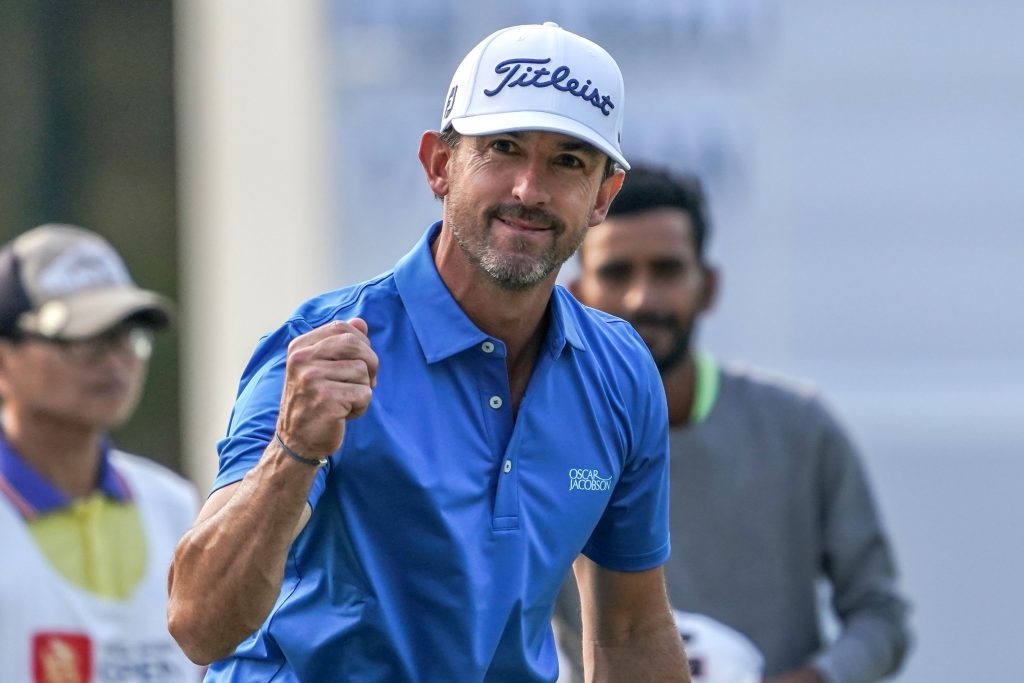
Australia’s Wade Ormsby and American Trevor Simsby – the Asian Tour’s top-two ranked players on the Order of Merit – will play in the opening tee-times today in the World Golf Championships-Workday Championship at The Concession, in Florida – the first WGC event of the year.
Ormsby – ranked first on the Merit list thanks to his win in last year’s Hong Kong Open – tees-off at 10.58am (Florida time) with South African Eric van Rooyen and Brendon Todd from the Unites States.
Last year’s Malaysian Open winner, Simsby, starts at the same time, but on the 10th with Australian Minwoo Lee – the brother of LPGA star Minjee Lee.
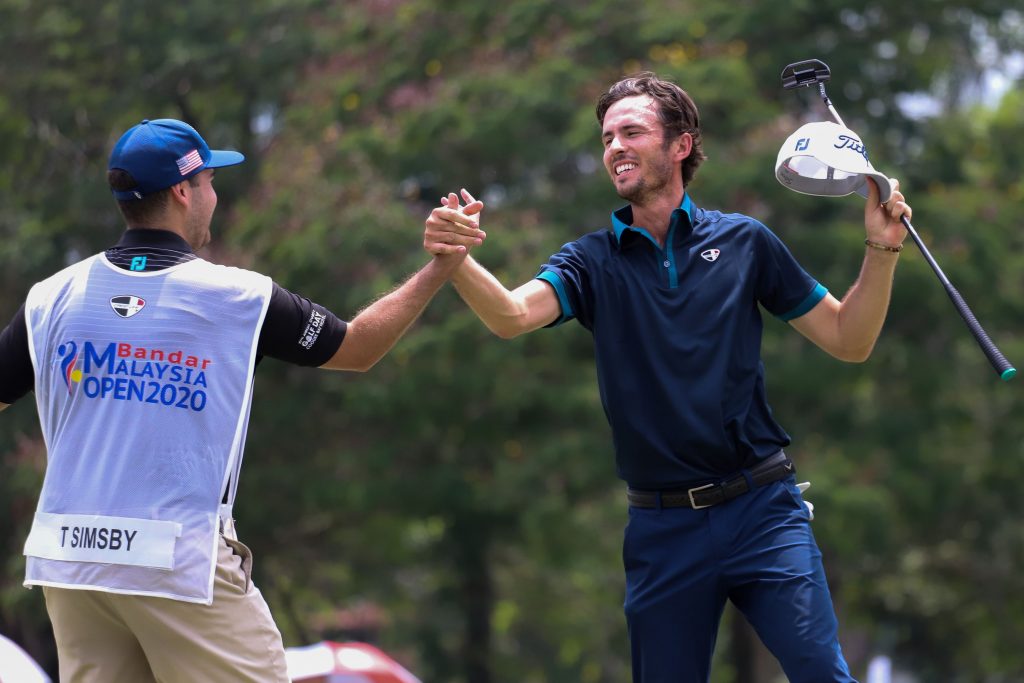
(Photo by Sadiq Asyraf/Getty Images)
The tournament is being played at The Concession Golf Club, and boasts prizemoney of US$10.5 million. The event was due to be played in Mexico but logistical challenges, posed by the COVID-19 pandemic, meant the location had to be changed.
Ormsby claimed the Hong Kong Open last January, for the second time in his career, and shot to the top of the Asian Tour Order of Merit.
Simsby soon joined him near the top of the Merit list by winning the Malaysian Open in March, before the pandemic brought the season to an abrupt halt.
This will mark the third time Ormsby has played in a WGC event, while its Simsby’s debut.
American Patrick Reed claimed the title last year; his compatriot Dustin Johnson triumphed in 2019 and 2017; while another American Phil Mickelson won in 2018.
World number one Johnson starts as hot favourite and has been paired with compatriots Brooks Koepka and Patrick Berger.
WGC events feature a field a of 72 players with no halfway cut.
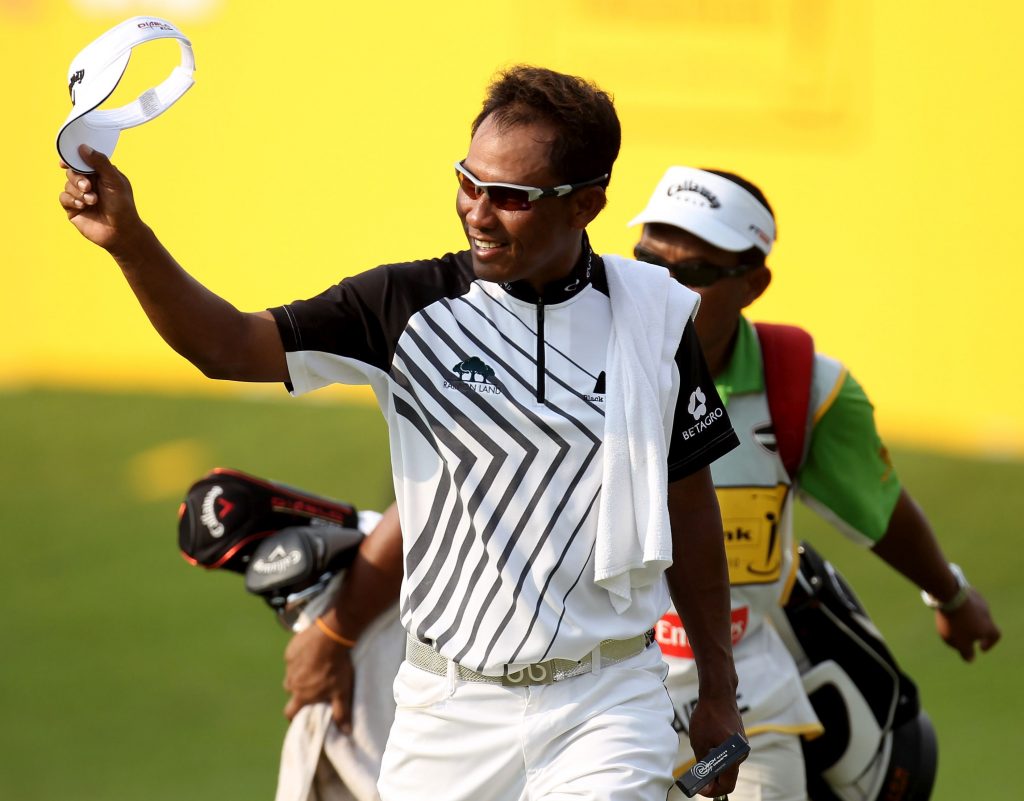


Thailand’s Thongchai Jaidee successfully defended his Malaysian Open crown on this day, 16 years ago. Perhaps, more than any of his victories – to date he has claimed 13 on the Asian Tour, and eight on the European Tour – this event defined him as a player. We look back at those two memorable victories, both played at Saujana Golf & Country Club.
Thongchai Jaidee had already tasted victory on five occasions by the time he arrived at the Malaysian Open in 2004.
In fact, he had claimed the Myanmar Open the week beforehand – for the second time in his career – and so started the National Open of Malaysia as one of the favourites.
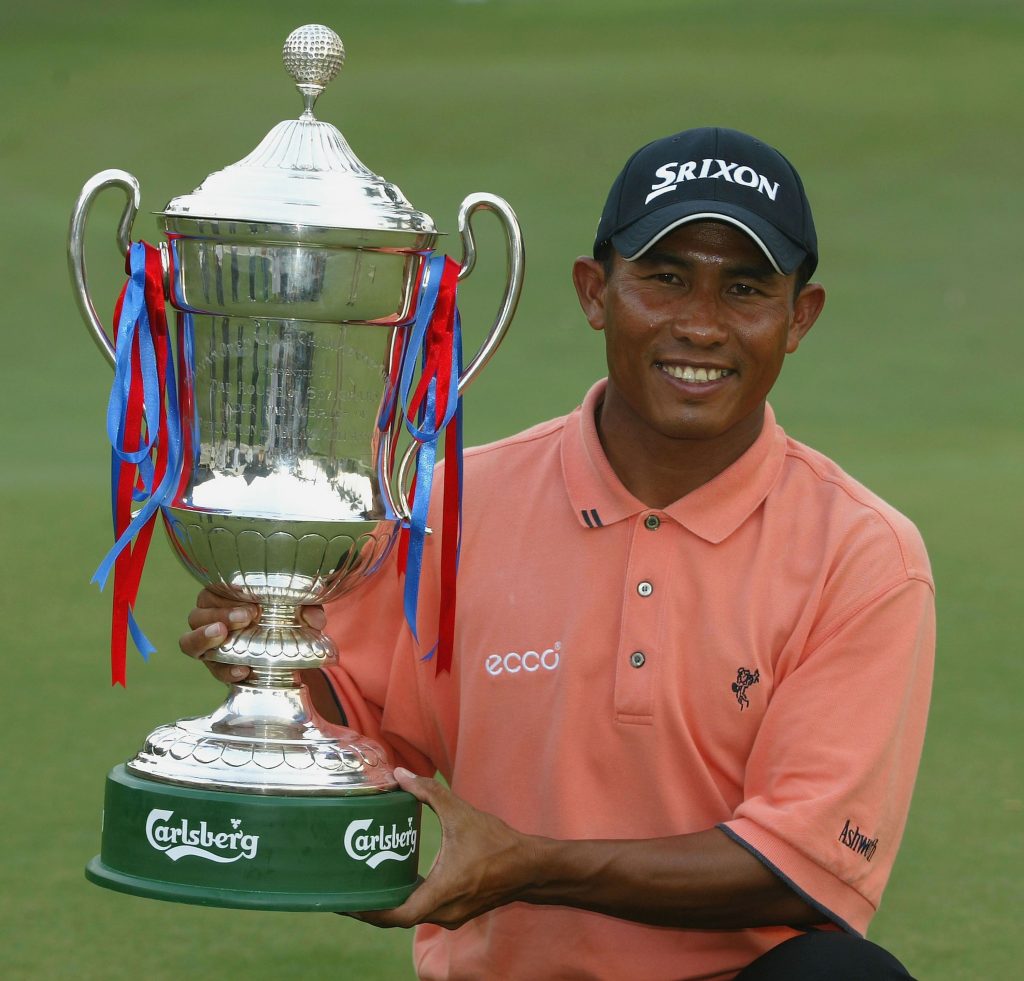


KUALA LUMPUR, MALAYSIA – FEBRUARY 22: Thongchai Jaidee of Thailand poses with the trophy for winning The Carlsberg Malaysian Open Golf at Saujana Golf and Country Club on February 22, 2004 in Kuala Lumpur, Malaysia. (Photo by Stuart Franklin/Getty Images)
Ace Performance
He faced a formidable field as, for the fifth year on-the-trot, the tournament was jointly-sanctioned by the Asian and European Tours. Ireland’s Padraig Harrington – who was beaten in a play-off by Fijian Vijay Singh at the event three years before – Denmark’s Thomas Bjorn, Irishman Paul McGinley and Sweden’s emerging young star Henrik Stenson, were some of the headline acts.
It was, no doubt, the quality of the field that helped contributed to Thongchai’s virtuoso performance.
That week, he created a piece of European Tour history when he became the first player from Thailand to win on the European Tour – the anniversary of which is on Monday, February 22 – with a two-stroke victory over Australian Brad Kennedy.
After struggling on the front nine on Sunday, he raced home in a blistering 30 strokes, highlighted by that most celebrated of golf shots – an ace on the par-three 16th.
He had been tied for the lead with three holes to play and magnificently rose to the challenge by spectacularly sinking a six iron from 188 yards, for the second ace of his professional career. A birdie on the last gave him a closing round of 68, four under par, for a 14 under par total winning total of 274.
Hs compatriots Prayad Marksaeng and Chawalit Plaphol, tied for third, four shots back, along with Frenchman Thomas Levet.
It was also Thongchai’s third win in six starts, as he also won the Volvo Masters of Asia at the end of 2003.
“It’s been my dream to play on the European Tour and now I will have to get used to life in Europe,” he said. “I’m looking forward to taking the opportunity to play alongside some of the best players in the world.”
The winners’ cheque of €158,153 (approximately US$191,000) was the largest of his career at the time, and he also became the sixth player from the Asian continent to win on the European Tour, along with India’s Arjun Atwal, Isao Aoki from Japan, Korean KJ Choi, Taiwan’s Yeh Wei-tze and Zhang Lian-wei from China.
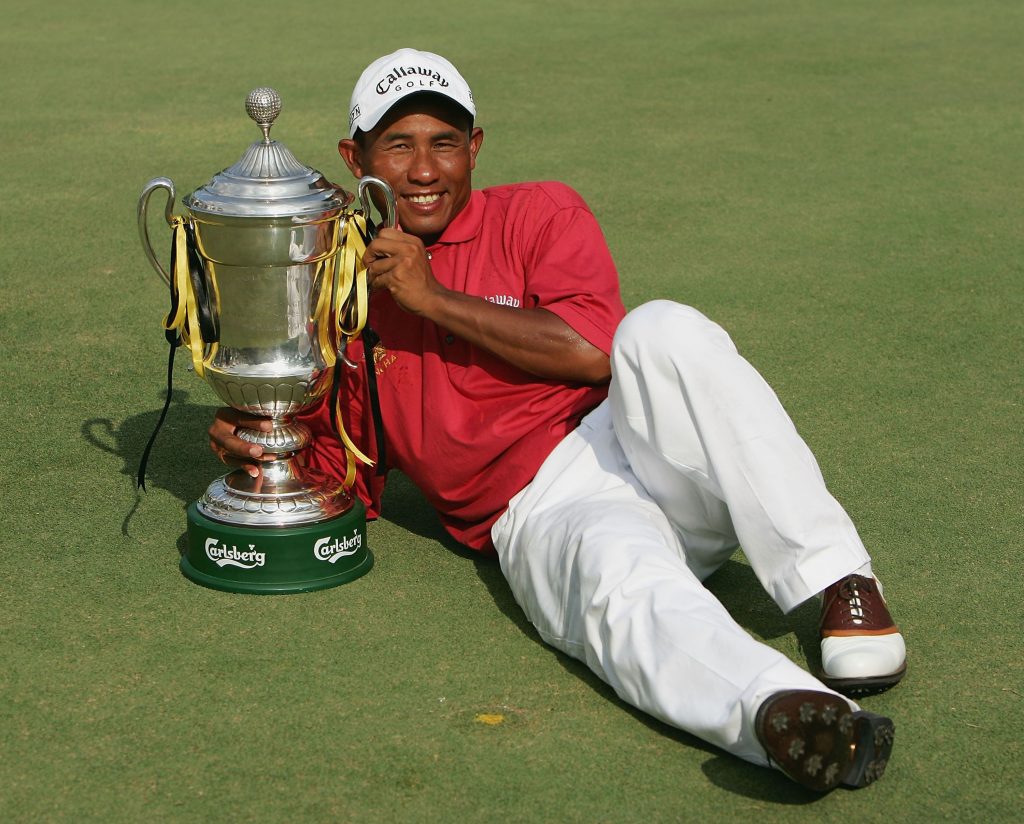


KUALA LUMPUR, MALAYSIA – FEBRUARY 20: Thongchai Jaidee of Thailand with the trophy for winning The Carlsberg Malaysian Open at Saujana Golf Resort on February 20, 2005 in Kuala Lumpur, Malaysia. (Photo by Stuart Franklin/Getty Images)
Back-to-back brilliance
The circumstances of his victory the following year were somewhat more relaxed, as he started the final round with a six-shot lead and eventually triumphed by three, but there were a few anxious moments when Stenson and India’s Jyoti Randhawa, the closest challengers, sensed an opening.
Thongchai bogeyed the ninth and then drove out of bounds with a hooked drive on the 11th; but he steadied the ship with his second ball: holing from eight feet to drop just the one stroke and maintain a two-stroke advantage.
At that stage most of the pressure was coming from Stenson who was making huge strides into the seven shot deficit he faced at the start of the round. Four birdies on the front nine closed the gap to three and his birdie on the 11th left him only two adrift.
But 13 lived up to its tag and proved unlucky. Pressing for an eagle three, Stenson misjudged the wind and pulled his seven iron approach. His ball ended up sitting on top of the rocks by the edge of the water and, in attempting to nick it clean off the stone, the clubhead bounced and he only moved the ball forward a few feet. His next chip ran 10 feet past and, to his astonishment, the par putt stayed out.
Thongchai, playing in the final group behind Stenson, responded with a birdie on that hole: pitching to within a couple of feet to restore his four-shot cushion over the Swede.
Thongchai’s closing 70 gave him a winning total of 21-under-par total of 267 – three clear of Randhawa, with Stenson a further shot adrift.
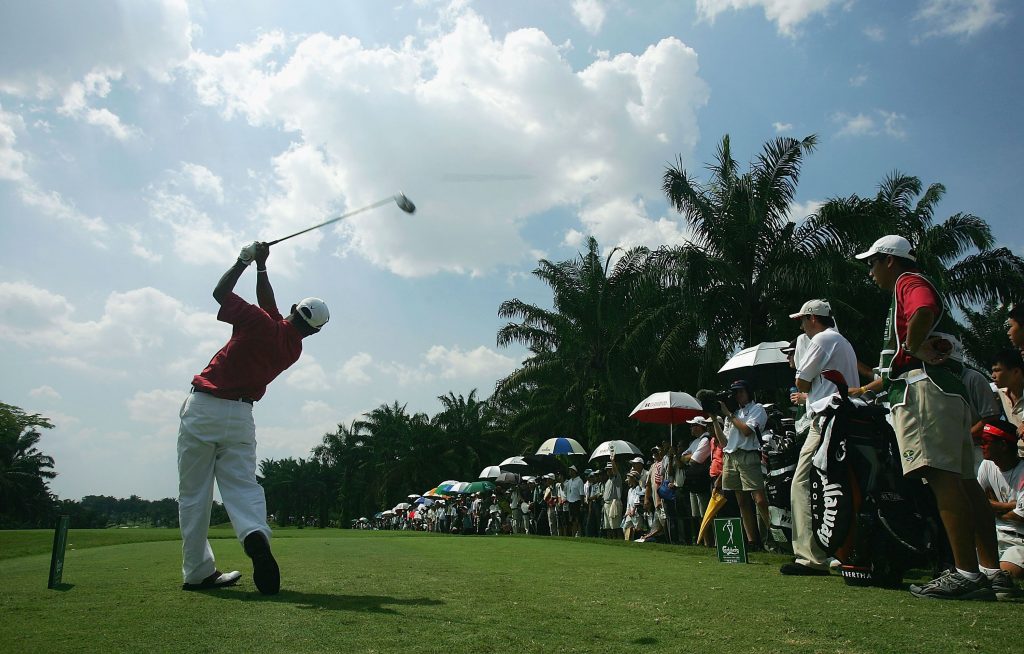


KUALA LUMPUR, MALAYSIA – FEBRUARY 20: Thongchai Jaidee of Thailand plays his tee shot on the 15th hole during the final round of The Carlsberg Malaysian Open at Saujana Golf Resort on February 20, 2005 in Kuala Lumpur, Malaysia. (Photo by Stuart Franklin/Getty Images)
The Thai star’s win saw him join a select group of players to have won the event back-to-back, the others being: Australian Graham Marsh (1974-75), and Japan’s Tomo Ishii (1964-65).
It also earned him a cheque for €156,763 (approximately US$190,000) and it was his seventh Asian Tour victory, placing him alongside Korea’s Wooksoon Kang as the most prolific winners on the Asian Tour at the time.
“This feels fantastic,” said Thongchai. “This win is better than last year. I just told myself to play my own game. The driver didn’t work well for me today but the irons worked nicely.”
Thongchai would go onto to win another 10 titles on Tour after that and complete his place among the greats of Asian golf
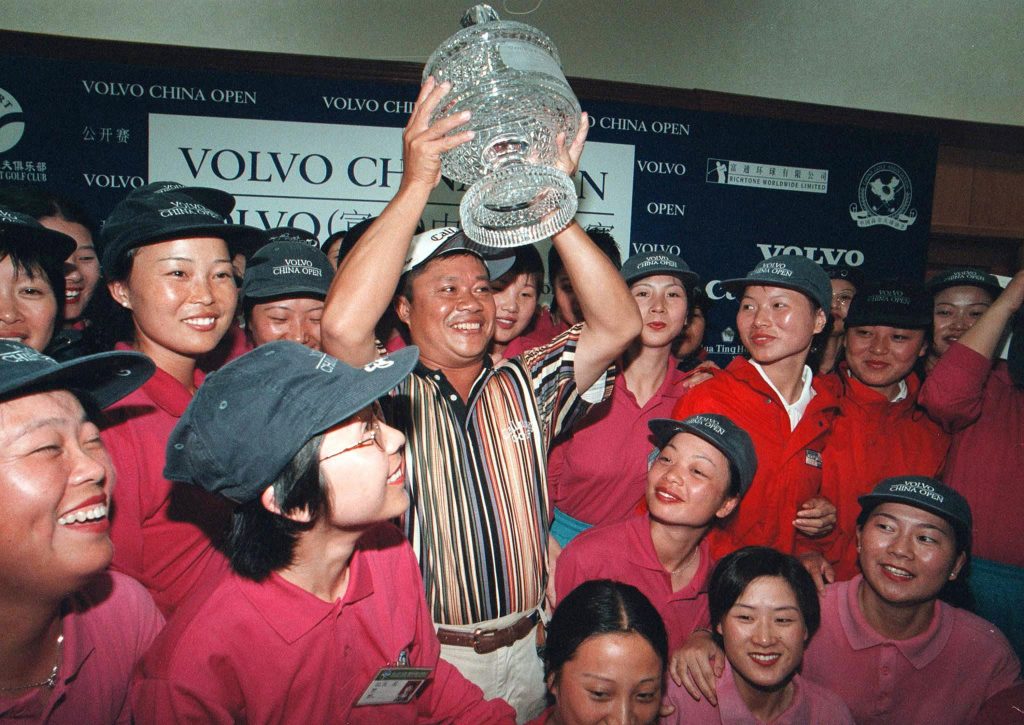


We asked Myanmar legend Kyi Hla Han, who turns 60-years-old today, nine questions about his unparalleled 25-year playing career.
Favourite tournament?
My career spanned 25 years. In the early 90’s the Johnnie Walker Classic was one of the best tournaments in Asia. It was played on really good courses with top-class star players and the atmosphere of the event was incredible. The same goes with tournaments in Australia – like the Australian Open and Australian Masters. It was fun to play in Melbourne.
In Asia in the last 15 years, the Singapore Open, the Maybank Championship and the Hong Kong Open are my favourite events; they are played on really good courses and the events have a great atmosphere.
Favourite course?
I don’t have a real favourite but I prefer the old traditional layouts. During my career I was fortunate to play the Sandbelt courses in Melbourne; Kingston Heath and Royal Melbourne are, in particular, my favourites. Especially the way the holes are designed, the bunkering, and the fact they test shot making. They don’t favour a particular kind of shot, you need to play all kinds of shots. Even in recent times the scores were not low on those courses, which shows that power doesn’t come into play. The same would apply to great Open courses like Muirfield, Carnoustie, Royal Birkdale etc. I would love to have played US Opens on traditional layouts like Winged Foot, Baltusrol, Marion etc
Closer to home, Sentosa’s Serapong Course is right up there, as is the Composite Course at the Hong Kong Golf Club ― used during the Hong Kong Open ― plus Delhi Golf Club and Royal Calcutta, come to mind. There are a lot of good courses in Thailand too.
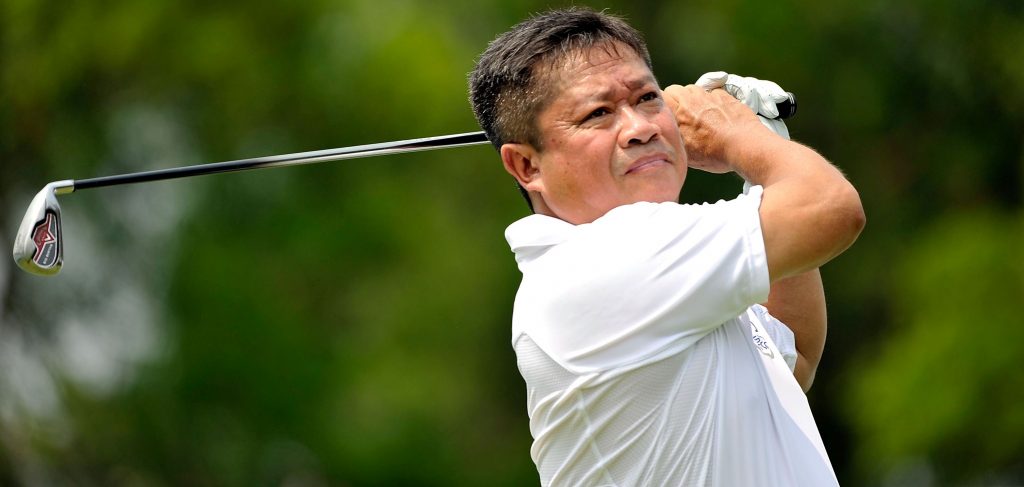


(Photo by Paul Lakatos/Asian Tour via Getty Images)
You won 12 times during your career. Which one did you enjoy the most?
My best win would be the 1999 Volvo China Open. It was raining and windy all four days and I won by eight shots. My father walked with me for all four days in that weather and he was 75-years-old! After that win I played well all year and won the Asian Tour Order Of Merit. The 1994 Singapore Open at Tanah Merah and the 1997 Rolex Singapore Masters at SICC Bukit were also memorable, and ironically I’m living in Singapore now!
Best thing about being a Tour pro?
I had wanted to be a pro golfer since I was 10 years old. I’ve been very fortunate to pursue a sport that I loved. Traveling all over the world, meeting new people, making so many friends, and playing a lot of great tournaments and golf courses. I was the only Asian playing in Europe in the 80s and in Australia. I cherish those moments. And, now that I have stopped playing, I reflect on those moments all the time.
I played in Europe for about five years. When I didn’t get into the main tour events I played the tours in Sweden and France, Germany and Italy. There wasn’t a structured Challenge tour in those days. In those days we kind of made up our own tour and a lot of players just travelled together. In the summer I played in Europe and then in October I went to Australia. And then I played the old Asian Tour from February to April. Without any centralized circuit we played around the world. Pretty much most of the players did the same thing.
I tried the US PGA Tour Q School five times, and got to the finals but never really got my card. I could have stayed there more, and played mini tours, but I decided the best thing was to play around the world. Maybe I was just burnt out by the time I played in their Q School in September/October. That was a disappointment but I have had a lot of enjoyment from being a Tour pro.



(Photo by Stanley Chou/AFP via Getty Images)
Most nervous you have been on the course?
The first tee shot at St Andrews in the 2000 Open Championship, and also the first tee shot playing with Tiger Woods in the 2000 Johnnie Walker Classic at Alpine, in Bangkok. The first tee shot was nerve-racking, but after that I was okay. Thinking back, it’s those nervous moments that I cherish. I miss the competition and playing with a lot of pressure, even if your heart is beating like crazy and your palms are sweaty … it’s what I miss.
What do you consider is the best shot of your career?
I really remember the drive I hit on the last hole of the 1994 Singapore Open at Tanah Merah. I had a one-shot lead and I knew if I hit a good drive I’d be ok. I was really nervous but I hit the longest and straightest drive of the four days. The first three days I had a four or five iron in for my second on that hole but I had an easy seven on the last day. I used a Callaway Big Bertha – they had just come out – and a Titleist balata 90. I used that ball because it was soft, it didn’t go far, but with my irons I got a lot of control, I like to work the ball.
Worst shot of your career?
I shanked a shot playing with Tiger Woods in the 2000 Johnnie Walker Classic. That was probably the most embarrassing because it was a par five at Alpine. It was over water and I hit a great second shot just over the green and was looking at a birdie; it was an easy chip but I shanked it and I made six.
And, there was once in Australia when I was leading a tournament and I had a two-shot lead going into the last day. The first hole was a par five and I hit my second 10 yards short of the green but I basically just chunked my third and made six, and pretty much didn’t have a good round.



(Photo by Paul Lakatos/Asian Tour/Asian Tour via Getty Images)
Your best ever putt?
It wasn’t through putts that I won tournaments, there wasn’t a key putt. I remember the putt I made on 17 in the Korean Open in 1999, I was going head-to-head with KJ Choi. I was one behind and I had a 30-footer downhill that was almost impossible to make, but I holed it to put some pressure on him and to go one back into the last hole. I hit a great shot into 10 feet on the last but I missed it and I lost by a shot.
And the same year in the Taiwan Open I was one behind, and I made a 20-footer on the last hole to put pressure on Wooksoon Kang, but he made a 20-footer on top of me to win by one.
I made those putts when I really needed them; I still think about those putts. I was using the broom handle putter then ― I had switched in 1996 ― and I am still using that putter today. It’s in my bag; they don’t make them anymore.
Who is your favourite golfer?
I grew up admiring Jack Nicklaus. My father was a big fan of Jack and he gave that book Golf My Way by Jack Nicklaus. I basically learned a lot from that book. I was 10 years old and that book was my bible. I met Jack at the 2013 Presidents Cup, when it was held at his course Muirfield Village in Ohio. I was Chairman of the Asian Tour, and I got to have lunch with him. I told him that I learned golf from his book and he said he’d give me another one with his signature on it!
Nowadays it would be Tiger Woods. When I played with him in 2000, I could see that there would not be a player like him for a long time.



Han in action during the Johnnie Walker Hongkong Open in 1989. (Photo by Chu Ming-hoi/South China Morning Post via Getty Images).
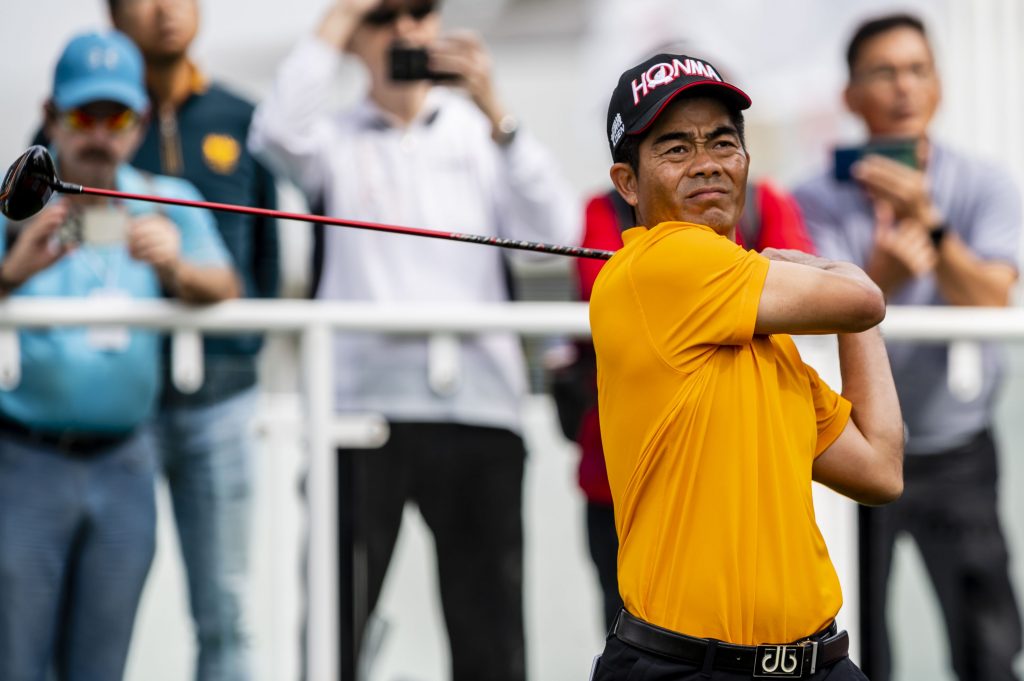


Former Asian Tour number one Liang Wen-chong, from China, has called for “everyone to work together to fight off the pandemic”, and has taken a safe and sensible approach to the life-changing developments caused by COVID-19.
Speaking from his home in Hengdian, Zhejiang Province, China ― where he is currently celebrating the Lunar New Year with family and friends ― he said: “In what has been a season of rest, for most of last year, I told myself to stay positive. The pandemic is something that will catch you off guard, but it has since become a norm for most. What we need to do is to adapt to it and make changes to our daily lives.
“It’s a new knowledge, so we need to have patience and face it with determination. Everyone needs to work together to fight off the pandemic, hoping life will return to usual in the near future.



(Photo by Arep Kulal/Getty Images)
“Thanks to this pandemic, I have learned how important it is to stay physically fit. Regular exercise can improve your resistance to virus. Therefore, golf is a good option too.”
The 42-year-old played in the Asian Tour events at the start of last year, before the pandemic hit, and was able to compete in a couple of events in Japan, at the end of the year.
“The pandemic affected all golfers and Tours; schedules were changed; tournaments were postponed or suspended. I can only stay at home when there are no tournaments to play. It was back to playing my role as a father and doing my best to adhere to all safety measures.”
Liang has enjoyed a decorated career, to date.
He succeeded his mentor Zhang Lian-wei ―China’s pioneering first world-class player ― by recording achievements after achievements, including: winning three times on the Asian Tour; claiming two titles in Japan; becoming the first player from the mainland to compete in the US PGA Championship; and, at the Open in 2008, becoming the first Chinese golfer to make the cut at a Major.
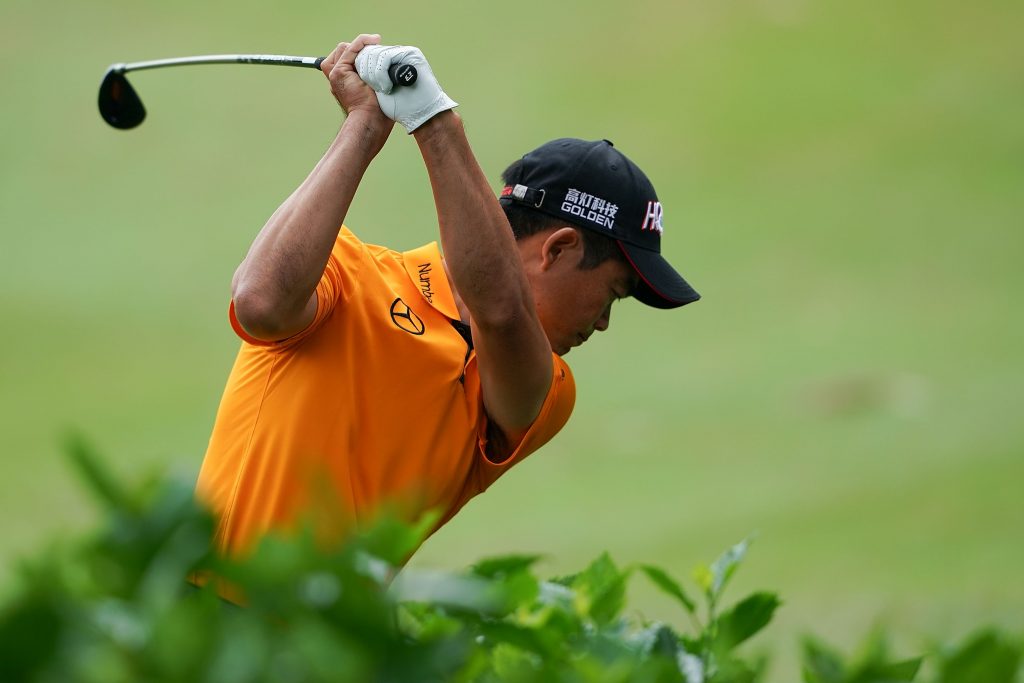


(Photo by Zhe Ji/Getty Images)
It was in 2007 when he won the Asian Tour Order of Merit title, the first player from China to achieve that feat. That year he also claimed the Singapore Masters ― which was co-sanctioned by the Asian Tour and the European Tour, and meant he became the second golfer from China to win on the European Tour, after Zhang.
“In this brand new 2021, I hope to return to the golf course for more tournaments and obtain good results,” added the Chinese star.
“My long-term goal in golf is to try and prolong my golfing career for as long as I can; maintain my competitiveness on the golf course; and at the same time, do my best in promoting and developing the game across the region.”



It is hard to believe that it was on this day 24 years ago when American Tiger Woods took Bangkok by storm and claimed the Asian Honda Classic at Thai Country Club, just outside Bangkok.
The region had rarely witnessed such a sporting occasion and the world’s media turned out in full force to cover his every move.
The young American had arrived in the Thai capital to much pomp and ceremony and at times frenzied excitement.
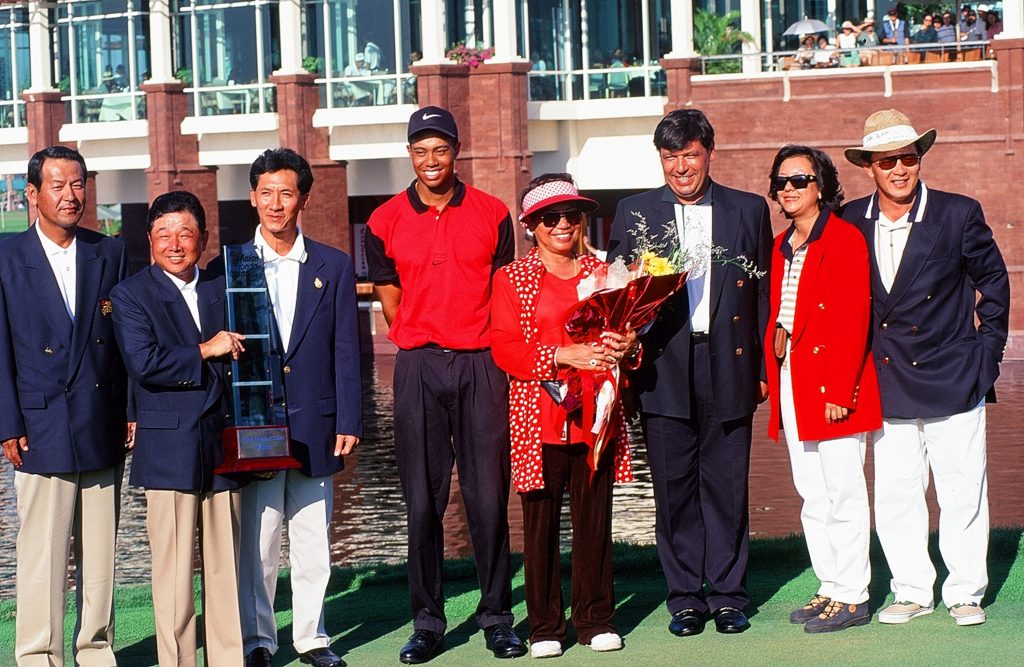


(Credit: Richard Castka/Sportfive)
He had competed in Thailand once before ― as an amateur in the 1994 Johnnie Walker Classic at Blue Canyon Country Club in Phuket ― but this was the first time he was playing there as a professional.
Aged 21 years old he was accompanied by his mother, Kultida, who grew up 70 miles north of Bangkok; she proudly chaperoned him throughout the week.
He was also surrounded by tight security during the trip ― which was much needed amid wild welcoming scenes at Don Muang airport.
Having only just turned professional the year before, he had already claimed three titles on the PGA Tour, although at this point he had not won Major.
Woods cruised to a 10-shot victory in the US$300,000 event; which also saw Australian Steve Elkington, Frank Nobilo from New Zealand and American Curtis Strange competing.



(Credit: Richard Castka/Sportfive)
He shot rounds of 70-64-66-68 for a brilliant four-round aggregate of 20-under-par 268; Korean Mo Joong Kyung secured second place.
He treated the fans to a level of golf they had never seen before, including driving the 389-yard par-four 10th hole during the third round.
It was a stunning performance, with his helicopter rides to and from the course adding to the spectacle.
Thousands of fans chanted his name as he walked down the 18th fairway on Sunday.
After the win, Tiger said: “Winning is great, but to win here in Thailand is something special. This is like home to me.”



(Credit: Richard Castka/Sportfive)
“I knew my swing wasn’t working well,” added Woods. “I made some bad shots out there, but I made some key putts and that’s what wins golf tournaments.”
Woods, who earned a cheque for US$48,000, had five birdies during the final round and nearly eagled the fourth hole. He had a bogey on the 17th hole when his drive sliced into the water.
Two months later he was to go on and win the US Masters for the first time ― by the incredible margin of 12 shots ― and commence a career that would see him win 15 Majors and 82 PGA Tour titles.
But few will forget how things began for him during that unforgettable week at the Asian Honda Classic ― nearly a quarter of a century ago.
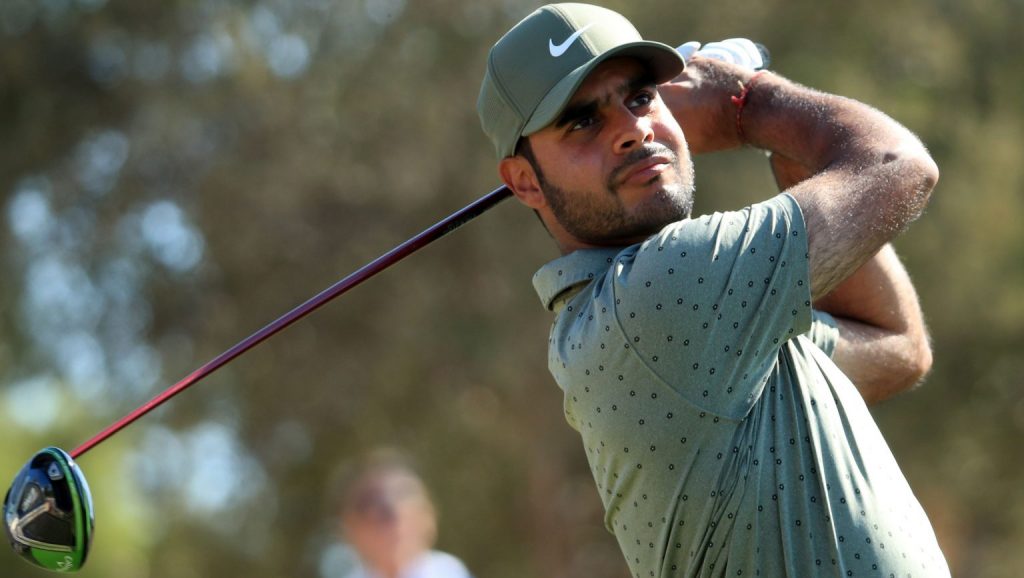


India’s Shubhankar Sharma feels he kick started his season with an encouraging performance in the Omega Dubai Desert Classic last week ― where he finished in a tie for 22nd place ― and is hoping to build upon that result in Saudi Arabia this week.
“I was playing so much better than what the score showed,” said the 24-year-old, who would have finished much higher if not for dropped shots over the closing holes. He three-putted the 15th for a bogey, dropped another shot on the next, after failing to get up and down, and made the green in two on the par-five 18th but three-putted once more.
“It was kind of a bummer in the end but it is fine. You have to look at the bigger picture and take things into perspective: I had a decent week; I played pretty solid; I hit the ball really well. I obviously left a few shots out there, especially on the weekend, but I am really happy with the way I battled hard,” added Sharma, who has been paired today with Jhonattan Vegas from Venezuela and Brandon Stone from South Africa in the first round of the Saudi International.



(Photo by Ross Kinnaird/Getty Images)
“We gave it our all and conditions were not easy, especially the last two days when it got really windy. We hung in there and I am pretty pleased with the result, considering it is only the second event of the season. There is still a long way to go but it gives me something to build upon now.”
The Indian star missed the cut in Abu Dhabi the previous week: which he says what partly because a fog delay on day one, which saw him get stuck in poor weather and meant he had to finish his first round on Friday, and also because he drove the ball badly.
He said: “I really worked hard on my driving after missing the cut, and it paid off as my driving was one of the best parts of my game in Dubai, and that is why I had some good scores.”
CHANDIGARH BREAK
Sharma said he was also refreshed from a month’s break, at home in Chandigarh.
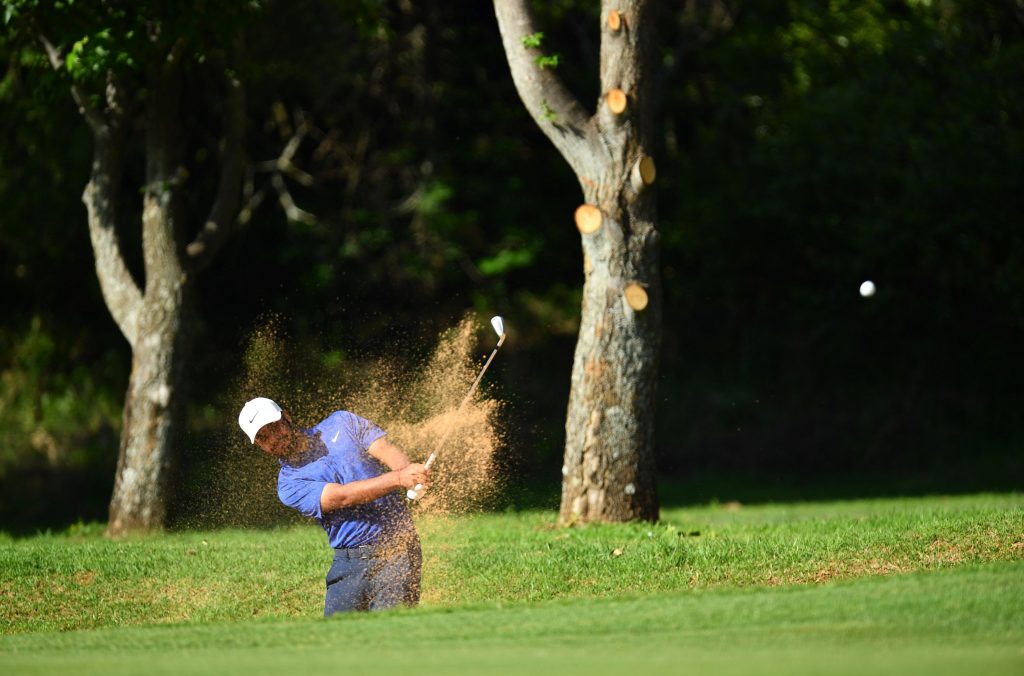


JOHANNESBURG, SOUTH AFRICA – NOVEMBER 19: Shubhankar Sharma of India plays his second shot on the 10th hole during Day One of the Joburg Open at Randpark Golf Club on November 19, 2020 in Johannesburg, South Africa. (Photo by Stuart Franklin/Getty Images)
He spent the time working with his long-time coach Jesse Grewal as well as Gurbaz Mann.
“Every time you go home you work on rectifying the mistakes of the previous year. Jesse has been my coach since I was 10 years old, while Gurbaz ― a former Asian Tour player ― came on board the last four or five years,” said Sharma.
“I worked a lot with Gurbaz: he built all my clubs, we got new irons in ― same model, just a newer set ― changed wedges and worked on the putter and the three wood, and did some tweaks. I worked on my swing with both of them. It was quite useful that one month I had back there. We worked on small things. I think every golfer has certain tendencies they are trying to avoid and it’s the same with me. I get into these bad habits and tendencies which I have to keep fixing.”
He also spent a lot of time in the gym trying help his body recover from a challenging 2020 playing on the European Tour.
He said: “Last year was especially long for me, especially towards the end; I was out there for almost five months. That definitely took a toll on the body, especially being in the bubble and not being able to travel, not being able to go outside, just being in the hotel and golf course. There were a lot of small issues in the body we had to fix. I was working a lot with my physiotherapist and my trainer back home. I think that helped me even more than going to practice.”
Sharma was stuck at home for about two months at the beginning of last year when COVID-19 first put the world into lockdown. He didn’t play any golf during that period, apart from practicing his chipping at a park in front of his house.
RETURN TO EUROPE
But he said the layoff did allow him to reset mentally and physically before returning to action on the European Tours, for their UK Swing in August.
“I was not at my best in the beginning,” said Sharma, who missed the cut in five out of his first six events.
“I was struggling with my swing – I was slightly rusty – and the weather in Europe. I made some mental mistakes in the first few rounds and that saw me exit before the weekend. But you learn so much more from being out on Tour compared with being home and practicing. You get feedback from playing in tournaments and that really helps.”
“But after that, since Portugal in September, I started to play really well. I was really happy when I played well all the weeks when it was really cold: the BMW PGA Championship, the events in Ireland and Scotland ― it was really cold and we don’t grow up playing in that weather in Asia.”
MAYBANK MAGIC
While this week he will be looking to build on his Dubai result, he will also hope to draw on what he achieved on this day three years ago: winning the 2018 Maybank Championship in Malaysia.
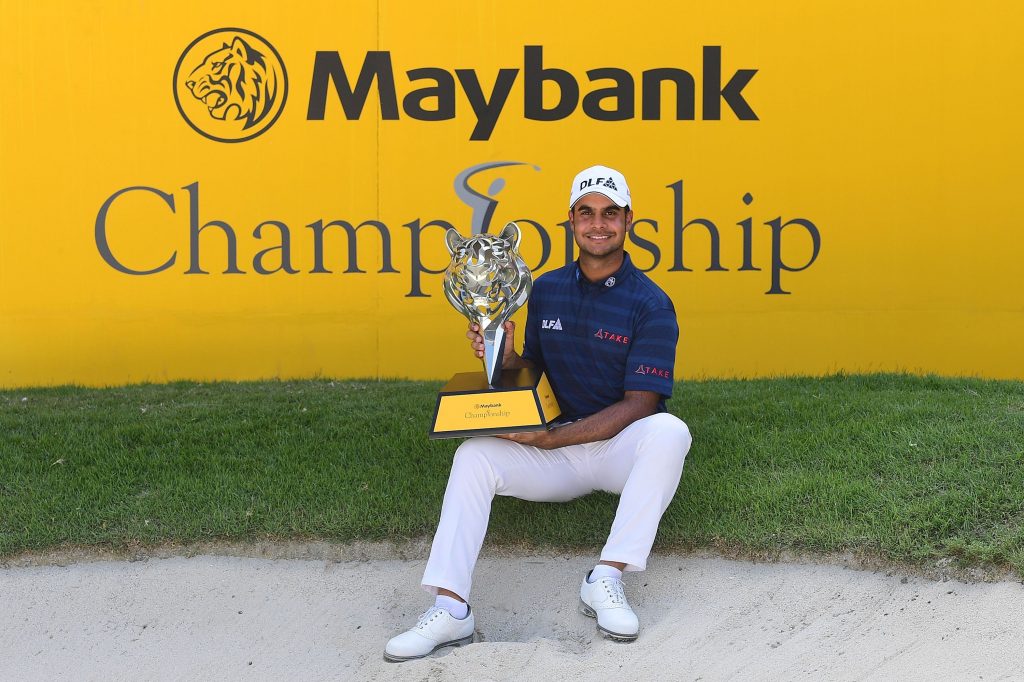


KUALA LUMPUR, MALAYSIA – FEBRUARY 04: Shubhankar Sharma of India poses with the trophy after winning the 2018 Maybank Championship at Saujana Golf and Country Club (Photo by Arep Kulal/Asian Tour/Asian Tour via Getty Images,)
“Maybank changed my life,” said Sharma.
“It got me into a lot of big events: I played all the Majors that year.”
He won the Maybank tournament ― which was joint-sanctioned by the Asian Tour and European Tour ― after shooting a final round 10-under-par 62, having started Sunday four off the lead.
The win also came less than two months after he claimed the Joburg Open ― which was also jointly-sanctioned and his maiden win on both Tours.
“I have great memories of that 62. I remember going out on the last day, I wasn’t really thinking of winning. I had a fever the week before and I was just starting to feel better that week,” he said.
“I was just hoping for a good round on the last day and finishing in top 10. I didn’t make birdie on the first hole, which is an easy par five, but I made birdie on four, five, six, seven and nine. I was five under on the front.
“It was one of those days when I wasn’t missing too many shots, and everything fell into place. I looked at the leaderboard on 16 and realized I was two or three ahead but the leaders were way behind me, on nine or 10, and so they had a lot more holes to play.
“I just told myself to keep giving myself chances and that it is not over until it’s over. I was eight under [for the round], missed a birdie on 16 but birdied 17 and 18 and once I did that I knew it would be very hard to catch me. It was a great feeling, I left it all out there.”


Ormsby and Simsby start first at WGC event
By - simon
[addtoany]


The Asian Tour’s top two ranked players all set for big event.
Australia’s Wade Ormsby and American Trevor Simsby – the Asian Tour’s top-two ranked players on the Order of Merit – will play in the opening tee-times today in the World Golf Championships-Workday Championship at The Concession, in Florida – the first WGC event of the year.
Ormsby – ranked first on the Merit list thanks to his win in last year’s Hong Kong Open – tees-off at 10.58am (Florida time) with South African Eric van Rooyen and Brendon Todd from the Unites States.
Last year’s Malaysian Open winner, Simsby, starts at the same time, but on the 10th with Australian Minwoo Lee – the brother of LPGA star Minjee Lee.



(Photo by Sadiq Asyraf/Getty Images)
The tournament is being played at The Concession Golf Club, and boasts prizemoney of US$10.5 million. The event was due to be played in Mexico but logistical challenges, posed by the COVID-19 pandemic, meant the location had to be changed.
Ormsby claimed the Hong Kong Open last January, for the second time in his career, and shot to the top of the Asian Tour Order of Merit.
Simsby soon joined him near the top of the Merit list by winning the Malaysian Open in March, before the pandemic brought the season to an abrupt halt.
This will mark the third time Ormsby has played in a WGC event, while its Simsby’s debut.
American Patrick Reed claimed the title last year; his compatriot Dustin Johnson triumphed in 2019 and 2017; while another American Phil Mickelson won in 2018.
World number one Johnson starts as hot favourite and has been paired with compatriots Brooks Koepka and Patrick Berger.
WGC events feature a field a of 72 players with no halfway cut.



We look back at Thongchai’s remarkable success at Saujana.
Thailand’s Thongchai Jaidee successfully defended his Malaysian Open crown on this day, 16 years ago. Perhaps, more than any of his victories – to date he has claimed 13 on the Asian Tour, and eight on the European Tour – this event defined him as a player. We look back at those two memorable victories, both played at Saujana Golf & Country Club.
Thongchai Jaidee had already tasted victory on five occasions by the time he arrived at the Malaysian Open in 2004.
In fact, he had claimed the Myanmar Open the week beforehand – for the second time in his career – and so started the National Open of Malaysia as one of the favourites.



KUALA LUMPUR, MALAYSIA – FEBRUARY 22: Thongchai Jaidee of Thailand poses with the trophy for winning The Carlsberg Malaysian Open Golf at Saujana Golf and Country Club on February 22, 2004 in Kuala Lumpur, Malaysia. (Photo by Stuart Franklin/Getty Images)
Ace Performance
He faced a formidable field as, for the fifth year on-the-trot, the tournament was jointly-sanctioned by the Asian and European Tours. Ireland’s Padraig Harrington – who was beaten in a play-off by Fijian Vijay Singh at the event three years before – Denmark’s Thomas Bjorn, Irishman Paul McGinley and Sweden’s emerging young star Henrik Stenson, were some of the headline acts.
It was, no doubt, the quality of the field that helped contributed to Thongchai’s virtuoso performance.
That week, he created a piece of European Tour history when he became the first player from Thailand to win on the European Tour – the anniversary of which is on Monday, February 22 – with a two-stroke victory over Australian Brad Kennedy.
After struggling on the front nine on Sunday, he raced home in a blistering 30 strokes, highlighted by that most celebrated of golf shots – an ace on the par-three 16th.
He had been tied for the lead with three holes to play and magnificently rose to the challenge by spectacularly sinking a six iron from 188 yards, for the second ace of his professional career. A birdie on the last gave him a closing round of 68, four under par, for a 14 under par total winning total of 274.
Hs compatriots Prayad Marksaeng and Chawalit Plaphol, tied for third, four shots back, along with Frenchman Thomas Levet.
It was also Thongchai’s third win in six starts, as he also won the Volvo Masters of Asia at the end of 2003.
“It’s been my dream to play on the European Tour and now I will have to get used to life in Europe,” he said. “I’m looking forward to taking the opportunity to play alongside some of the best players in the world.”
The winners’ cheque of €158,153 (approximately US$191,000) was the largest of his career at the time, and he also became the sixth player from the Asian continent to win on the European Tour, along with India’s Arjun Atwal, Isao Aoki from Japan, Korean KJ Choi, Taiwan’s Yeh Wei-tze and Zhang Lian-wei from China.



KUALA LUMPUR, MALAYSIA – FEBRUARY 20: Thongchai Jaidee of Thailand with the trophy for winning The Carlsberg Malaysian Open at Saujana Golf Resort on February 20, 2005 in Kuala Lumpur, Malaysia. (Photo by Stuart Franklin/Getty Images)
Back-to-back brilliance
The circumstances of his victory the following year were somewhat more relaxed, as he started the final round with a six-shot lead and eventually triumphed by three, but there were a few anxious moments when Stenson and India’s Jyoti Randhawa, the closest challengers, sensed an opening.
Thongchai bogeyed the ninth and then drove out of bounds with a hooked drive on the 11th; but he steadied the ship with his second ball: holing from eight feet to drop just the one stroke and maintain a two-stroke advantage.
At that stage most of the pressure was coming from Stenson who was making huge strides into the seven shot deficit he faced at the start of the round. Four birdies on the front nine closed the gap to three and his birdie on the 11th left him only two adrift.
But 13 lived up to its tag and proved unlucky. Pressing for an eagle three, Stenson misjudged the wind and pulled his seven iron approach. His ball ended up sitting on top of the rocks by the edge of the water and, in attempting to nick it clean off the stone, the clubhead bounced and he only moved the ball forward a few feet. His next chip ran 10 feet past and, to his astonishment, the par putt stayed out.
Thongchai, playing in the final group behind Stenson, responded with a birdie on that hole: pitching to within a couple of feet to restore his four-shot cushion over the Swede.
Thongchai’s closing 70 gave him a winning total of 21-under-par total of 267 – three clear of Randhawa, with Stenson a further shot adrift.



KUALA LUMPUR, MALAYSIA – FEBRUARY 20: Thongchai Jaidee of Thailand plays his tee shot on the 15th hole during the final round of The Carlsberg Malaysian Open at Saujana Golf Resort on February 20, 2005 in Kuala Lumpur, Malaysia. (Photo by Stuart Franklin/Getty Images)
The Thai star’s win saw him join a select group of players to have won the event back-to-back, the others being: Australian Graham Marsh (1974-75), and Japan’s Tomo Ishii (1964-65).
It also earned him a cheque for €156,763 (approximately US$190,000) and it was his seventh Asian Tour victory, placing him alongside Korea’s Wooksoon Kang as the most prolific winners on the Asian Tour at the time.
“This feels fantastic,” said Thongchai. “This win is better than last year. I just told myself to play my own game. The driver didn’t work well for me today but the irons worked nicely.”
Thongchai would go onto to win another 10 titles on Tour after that and complete his place among the greats of Asian golf



A fascinating Q & A with the Myanmar legend – who turns 60 today.
We asked Myanmar legend Kyi Hla Han, who turns 60-years-old today, nine questions about his unparalleled 25-year playing career.
Favourite tournament?
My career spanned 25 years. In the early 90’s the Johnnie Walker Classic was one of the best tournaments in Asia. It was played on really good courses with top-class star players and the atmosphere of the event was incredible. The same goes with tournaments in Australia – like the Australian Open and Australian Masters. It was fun to play in Melbourne.
In Asia in the last 15 years, the Singapore Open, the Maybank Championship and the Hong Kong Open are my favourite events; they are played on really good courses and the events have a great atmosphere.
Favourite course?
I don’t have a real favourite but I prefer the old traditional layouts. During my career I was fortunate to play the Sandbelt courses in Melbourne; Kingston Heath and Royal Melbourne are, in particular, my favourites. Especially the way the holes are designed, the bunkering, and the fact they test shot making. They don’t favour a particular kind of shot, you need to play all kinds of shots. Even in recent times the scores were not low on those courses, which shows that power doesn’t come into play. The same would apply to great Open courses like Muirfield, Carnoustie, Royal Birkdale etc. I would love to have played US Opens on traditional layouts like Winged Foot, Baltusrol, Marion etc
Closer to home, Sentosa’s Serapong Course is right up there, as is the Composite Course at the Hong Kong Golf Club ― used during the Hong Kong Open ― plus Delhi Golf Club and Royal Calcutta, come to mind. There are a lot of good courses in Thailand too.



(Photo by Paul Lakatos/Asian Tour via Getty Images)
You won 12 times during your career. Which one did you enjoy the most?
My best win would be the 1999 Volvo China Open. It was raining and windy all four days and I won by eight shots. My father walked with me for all four days in that weather and he was 75-years-old! After that win I played well all year and won the Asian Tour Order Of Merit. The 1994 Singapore Open at Tanah Merah and the 1997 Rolex Singapore Masters at SICC Bukit were also memorable, and ironically I’m living in Singapore now!
Best thing about being a Tour pro?
I had wanted to be a pro golfer since I was 10 years old. I’ve been very fortunate to pursue a sport that I loved. Traveling all over the world, meeting new people, making so many friends, and playing a lot of great tournaments and golf courses. I was the only Asian playing in Europe in the 80s and in Australia. I cherish those moments. And, now that I have stopped playing, I reflect on those moments all the time.
I played in Europe for about five years. When I didn’t get into the main tour events I played the tours in Sweden and France, Germany and Italy. There wasn’t a structured Challenge tour in those days. In those days we kind of made up our own tour and a lot of players just travelled together. In the summer I played in Europe and then in October I went to Australia. And then I played the old Asian Tour from February to April. Without any centralized circuit we played around the world. Pretty much most of the players did the same thing.
I tried the US PGA Tour Q School five times, and got to the finals but never really got my card. I could have stayed there more, and played mini tours, but I decided the best thing was to play around the world. Maybe I was just burnt out by the time I played in their Q School in September/October. That was a disappointment but I have had a lot of enjoyment from being a Tour pro.



(Photo by Stanley Chou/AFP via Getty Images)
Most nervous you have been on the course?
The first tee shot at St Andrews in the 2000 Open Championship, and also the first tee shot playing with Tiger Woods in the 2000 Johnnie Walker Classic at Alpine, in Bangkok. The first tee shot was nerve-racking, but after that I was okay. Thinking back, it’s those nervous moments that I cherish. I miss the competition and playing with a lot of pressure, even if your heart is beating like crazy and your palms are sweaty … it’s what I miss.
What do you consider is the best shot of your career?
I really remember the drive I hit on the last hole of the 1994 Singapore Open at Tanah Merah. I had a one-shot lead and I knew if I hit a good drive I’d be ok. I was really nervous but I hit the longest and straightest drive of the four days. The first three days I had a four or five iron in for my second on that hole but I had an easy seven on the last day. I used a Callaway Big Bertha – they had just come out – and a Titleist balata 90. I used that ball because it was soft, it didn’t go far, but with my irons I got a lot of control, I like to work the ball.
Worst shot of your career?
I shanked a shot playing with Tiger Woods in the 2000 Johnnie Walker Classic. That was probably the most embarrassing because it was a par five at Alpine. It was over water and I hit a great second shot just over the green and was looking at a birdie; it was an easy chip but I shanked it and I made six.
And, there was once in Australia when I was leading a tournament and I had a two-shot lead going into the last day. The first hole was a par five and I hit my second 10 yards short of the green but I basically just chunked my third and made six, and pretty much didn’t have a good round.



(Photo by Paul Lakatos/Asian Tour/Asian Tour via Getty Images)
Your best ever putt?
It wasn’t through putts that I won tournaments, there wasn’t a key putt. I remember the putt I made on 17 in the Korean Open in 1999, I was going head-to-head with KJ Choi. I was one behind and I had a 30-footer downhill that was almost impossible to make, but I holed it to put some pressure on him and to go one back into the last hole. I hit a great shot into 10 feet on the last but I missed it and I lost by a shot.
And the same year in the Taiwan Open I was one behind, and I made a 20-footer on the last hole to put pressure on Wooksoon Kang, but he made a 20-footer on top of me to win by one.
I made those putts when I really needed them; I still think about those putts. I was using the broom handle putter then ― I had switched in 1996 ― and I am still using that putter today. It’s in my bag; they don’t make them anymore.
Who is your favourite golfer?
I grew up admiring Jack Nicklaus. My father was a big fan of Jack and he gave that book Golf My Way by Jack Nicklaus. I basically learned a lot from that book. I was 10 years old and that book was my bible. I met Jack at the 2013 Presidents Cup, when it was held at his course Muirfield Village in Ohio. I was Chairman of the Asian Tour, and I got to have lunch with him. I told him that I learned golf from his book and he said he’d give me another one with his signature on it!
Nowadays it would be Tiger Woods. When I played with him in 2000, I could see that there would not be a player like him for a long time.



Han in action during the Johnnie Walker Hongkong Open in 1989. (Photo by Chu Ming-hoi/South China Morning Post via Getty Images).



Chinese star has words of wisdom as we enter year of the Ox.
Former Asian Tour number one Liang Wen-chong, from China, has called for “everyone to work together to fight off the pandemic”, and has taken a safe and sensible approach to the life-changing developments caused by COVID-19.
Speaking from his home in Hengdian, Zhejiang Province, China ― where he is currently celebrating the Lunar New Year with family and friends ― he said: “In what has been a season of rest, for most of last year, I told myself to stay positive. The pandemic is something that will catch you off guard, but it has since become a norm for most. What we need to do is to adapt to it and make changes to our daily lives.
“It’s a new knowledge, so we need to have patience and face it with determination. Everyone needs to work together to fight off the pandemic, hoping life will return to usual in the near future.



(Photo by Arep Kulal/Getty Images)
“Thanks to this pandemic, I have learned how important it is to stay physically fit. Regular exercise can improve your resistance to virus. Therefore, golf is a good option too.”
The 42-year-old played in the Asian Tour events at the start of last year, before the pandemic hit, and was able to compete in a couple of events in Japan, at the end of the year.
“The pandemic affected all golfers and Tours; schedules were changed; tournaments were postponed or suspended. I can only stay at home when there are no tournaments to play. It was back to playing my role as a father and doing my best to adhere to all safety measures.”
Liang has enjoyed a decorated career, to date.
He succeeded his mentor Zhang Lian-wei ―China’s pioneering first world-class player ― by recording achievements after achievements, including: winning three times on the Asian Tour; claiming two titles in Japan; becoming the first player from the mainland to compete in the US PGA Championship; and, at the Open in 2008, becoming the first Chinese golfer to make the cut at a Major.



(Photo by Zhe Ji/Getty Images)
It was in 2007 when he won the Asian Tour Order of Merit title, the first player from China to achieve that feat. That year he also claimed the Singapore Masters ― which was co-sanctioned by the Asian Tour and the European Tour, and meant he became the second golfer from China to win on the European Tour, after Zhang.
“In this brand new 2021, I hope to return to the golf course for more tournaments and obtain good results,” added the Chinese star.
“My long-term goal in golf is to try and prolong my golfing career for as long as I can; maintain my competitiveness on the golf course; and at the same time, do my best in promoting and developing the game across the region.”



Nearly a quarter of a century ago, a 21-year-old Tiger Woods won the Asian Honda Classic in Bangkok – amid wild and, at times, frenzied scenes.
It is hard to believe that it was on this day 24 years ago when American Tiger Woods took Bangkok by storm and claimed the Asian Honda Classic at Thai Country Club, just outside Bangkok.
The region had rarely witnessed such a sporting occasion and the world’s media turned out in full force to cover his every move.
The young American had arrived in the Thai capital to much pomp and ceremony and at times frenzied excitement.



(Credit: Richard Castka/Sportfive)
He had competed in Thailand once before ― as an amateur in the 1994 Johnnie Walker Classic at Blue Canyon Country Club in Phuket ― but this was the first time he was playing there as a professional.
Aged 21 years old he was accompanied by his mother, Kultida, who grew up 70 miles north of Bangkok; she proudly chaperoned him throughout the week.
He was also surrounded by tight security during the trip ― which was much needed amid wild welcoming scenes at Don Muang airport.
Having only just turned professional the year before, he had already claimed three titles on the PGA Tour, although at this point he had not won Major.
Woods cruised to a 10-shot victory in the US$300,000 event; which also saw Australian Steve Elkington, Frank Nobilo from New Zealand and American Curtis Strange competing.



(Credit: Richard Castka/Sportfive)
He shot rounds of 70-64-66-68 for a brilliant four-round aggregate of 20-under-par 268; Korean Mo Joong Kyung secured second place.
He treated the fans to a level of golf they had never seen before, including driving the 389-yard par-four 10th hole during the third round.
It was a stunning performance, with his helicopter rides to and from the course adding to the spectacle.
Thousands of fans chanted his name as he walked down the 18th fairway on Sunday.
After the win, Tiger said: “Winning is great, but to win here in Thailand is something special. This is like home to me.”



(Credit: Richard Castka/Sportfive)
“I knew my swing wasn’t working well,” added Woods. “I made some bad shots out there, but I made some key putts and that’s what wins golf tournaments.”
Woods, who earned a cheque for US$48,000, had five birdies during the final round and nearly eagled the fourth hole. He had a bogey on the 17th hole when his drive sliced into the water.
Two months later he was to go on and win the US Masters for the first time ― by the incredible margin of 12 shots ― and commence a career that would see him win 15 Majors and 82 PGA Tour titles.
But few will forget how things began for him during that unforgettable week at the Asian Honda Classic ― nearly a quarter of a century ago.



Indian star Shubhankar Sharma – who won the Maybank Championship on this day three years ago – is hoping to play well this week in Saudi Arabia, after a strong showing in Dubai.
India’s Shubhankar Sharma feels he kick started his season with an encouraging performance in the Omega Dubai Desert Classic last week ― where he finished in a tie for 22nd place ― and is hoping to build upon that result in Saudi Arabia this week.
“I was playing so much better than what the score showed,” said the 24-year-old, who would have finished much higher if not for dropped shots over the closing holes. He three-putted the 15th for a bogey, dropped another shot on the next, after failing to get up and down, and made the green in two on the par-five 18th but three-putted once more.
“It was kind of a bummer in the end but it is fine. You have to look at the bigger picture and take things into perspective: I had a decent week; I played pretty solid; I hit the ball really well. I obviously left a few shots out there, especially on the weekend, but I am really happy with the way I battled hard,” added Sharma, who has been paired today with Jhonattan Vegas from Venezuela and Brandon Stone from South Africa in the first round of the Saudi International.



(Photo by Ross Kinnaird/Getty Images)
“We gave it our all and conditions were not easy, especially the last two days when it got really windy. We hung in there and I am pretty pleased with the result, considering it is only the second event of the season. There is still a long way to go but it gives me something to build upon now.”
The Indian star missed the cut in Abu Dhabi the previous week: which he says what partly because a fog delay on day one, which saw him get stuck in poor weather and meant he had to finish his first round on Friday, and also because he drove the ball badly.
He said: “I really worked hard on my driving after missing the cut, and it paid off as my driving was one of the best parts of my game in Dubai, and that is why I had some good scores.”
CHANDIGARH BREAK
Sharma said he was also refreshed from a month’s break, at home in Chandigarh.



JOHANNESBURG, SOUTH AFRICA – NOVEMBER 19: Shubhankar Sharma of India plays his second shot on the 10th hole during Day One of the Joburg Open at Randpark Golf Club on November 19, 2020 in Johannesburg, South Africa. (Photo by Stuart Franklin/Getty Images)
He spent the time working with his long-time coach Jesse Grewal as well as Gurbaz Mann.
“Every time you go home you work on rectifying the mistakes of the previous year. Jesse has been my coach since I was 10 years old, while Gurbaz ― a former Asian Tour player ― came on board the last four or five years,” said Sharma.
“I worked a lot with Gurbaz: he built all my clubs, we got new irons in ― same model, just a newer set ― changed wedges and worked on the putter and the three wood, and did some tweaks. I worked on my swing with both of them. It was quite useful that one month I had back there. We worked on small things. I think every golfer has certain tendencies they are trying to avoid and it’s the same with me. I get into these bad habits and tendencies which I have to keep fixing.”
He also spent a lot of time in the gym trying help his body recover from a challenging 2020 playing on the European Tour.
He said: “Last year was especially long for me, especially towards the end; I was out there for almost five months. That definitely took a toll on the body, especially being in the bubble and not being able to travel, not being able to go outside, just being in the hotel and golf course. There were a lot of small issues in the body we had to fix. I was working a lot with my physiotherapist and my trainer back home. I think that helped me even more than going to practice.”
Sharma was stuck at home for about two months at the beginning of last year when COVID-19 first put the world into lockdown. He didn’t play any golf during that period, apart from practicing his chipping at a park in front of his house.
RETURN TO EUROPE
But he said the layoff did allow him to reset mentally and physically before returning to action on the European Tours, for their UK Swing in August.
“I was not at my best in the beginning,” said Sharma, who missed the cut in five out of his first six events.
“I was struggling with my swing – I was slightly rusty – and the weather in Europe. I made some mental mistakes in the first few rounds and that saw me exit before the weekend. But you learn so much more from being out on Tour compared with being home and practicing. You get feedback from playing in tournaments and that really helps.”
“But after that, since Portugal in September, I started to play really well. I was really happy when I played well all the weeks when it was really cold: the BMW PGA Championship, the events in Ireland and Scotland ― it was really cold and we don’t grow up playing in that weather in Asia.”
MAYBANK MAGIC
While this week he will be looking to build on his Dubai result, he will also hope to draw on what he achieved on this day three years ago: winning the 2018 Maybank Championship in Malaysia.



KUALA LUMPUR, MALAYSIA – FEBRUARY 04: Shubhankar Sharma of India poses with the trophy after winning the 2018 Maybank Championship at Saujana Golf and Country Club (Photo by Arep Kulal/Asian Tour/Asian Tour via Getty Images,)
“Maybank changed my life,” said Sharma.
“It got me into a lot of big events: I played all the Majors that year.”
He won the Maybank tournament ― which was joint-sanctioned by the Asian Tour and European Tour ― after shooting a final round 10-under-par 62, having started Sunday four off the lead.
The win also came less than two months after he claimed the Joburg Open ― which was also jointly-sanctioned and his maiden win on both Tours.
“I have great memories of that 62. I remember going out on the last day, I wasn’t really thinking of winning. I had a fever the week before and I was just starting to feel better that week,” he said.
“I was just hoping for a good round on the last day and finishing in top 10. I didn’t make birdie on the first hole, which is an easy par five, but I made birdie on four, five, six, seven and nine. I was five under on the front.
“It was one of those days when I wasn’t missing too many shots, and everything fell into place. I looked at the leaderboard on 16 and realized I was two or three ahead but the leaders were way behind me, on nine or 10, and so they had a lot more holes to play.
“I just told myself to keep giving myself chances and that it is not over until it’s over. I was eight under [for the round], missed a birdie on 16 but birdied 17 and 18 and once I did that I knew it would be very hard to catch me. It was a great feeling, I left it all out there.”
Headlines at a glance
- Saudi Open presented by PIF: Statistically speaking
- Saudi Open presented by PIF: Catlin wins wire-to-wire and back-to-back
- Catlin looking unbeatable at Saudi Open presented by PIF with eight-shot lead
- Cool-headed Catlin coasting at Saudi Open presented by PIF
- PKNS Selangor Masters set for June date on Asian Development Tour
- April 2024
- March 2024
- February 2024
- January 2024
- December 2023
- November 2023
- October 2023
- September 2023
- August 2023
- July 2023
- June 2023
- May 2023
- April 2023
- March 2023
- February 2023
- January 2023
- December 2022
- November 2022
- October 2022
- September 2022
- August 2022
- July 2022
- June 2022
- May 2022
- April 2022
- March 2022
- February 2022
- January 2022
- December 2021
- November 2021
- October 2021
- September 2021
- August 2021
- July 2021
- June 2021
- May 2021
- April 2021
- March 2021
- February 2021
- January 2021
- December 2020
- November 2020
- October 2020
- September 2020
- August 2020
- July 2020
- June 2020
- May 2020
- April 2020
- March 2020
- February 2020
- January 2020
- December 2019
- November 2019
- October 2019
- September 2019
- August 2019
- July 2019
- June 2019
- May 2019
- April 2019
- March 2019
- February 2019
- January 2019
- December 2018
- November 2018
- October 2018
- September 2018
- August 2018
- July 2018
- June 2018
- May 2018
- April 2018
- March 2018
- February 2018
- January 2018
- December 2017
- November 2017
- October 2017
- September 2017
- May 2017
- March 2015
- April 2013
- March 2013
- February 2013
- January 2013
- January 2009

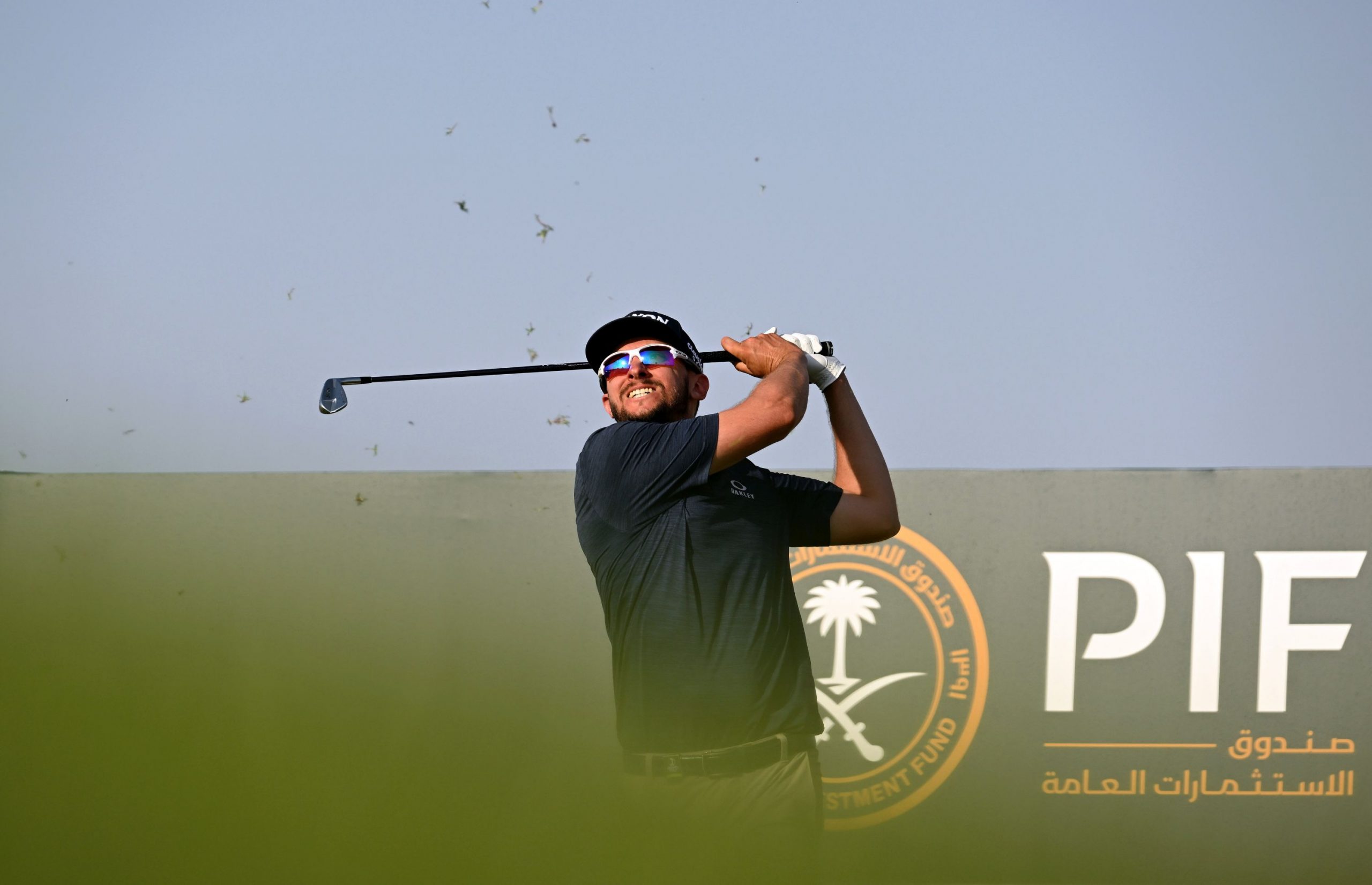
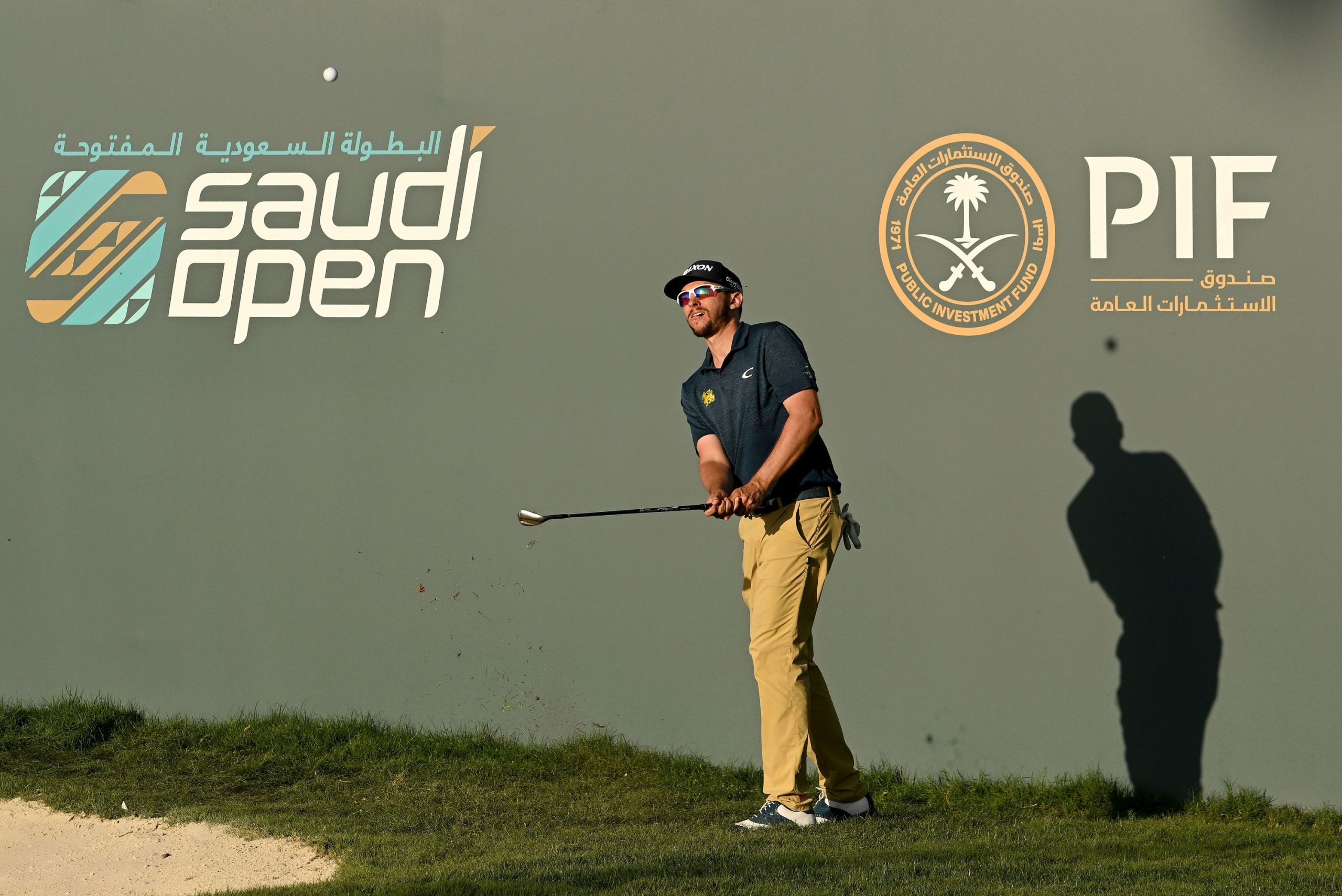
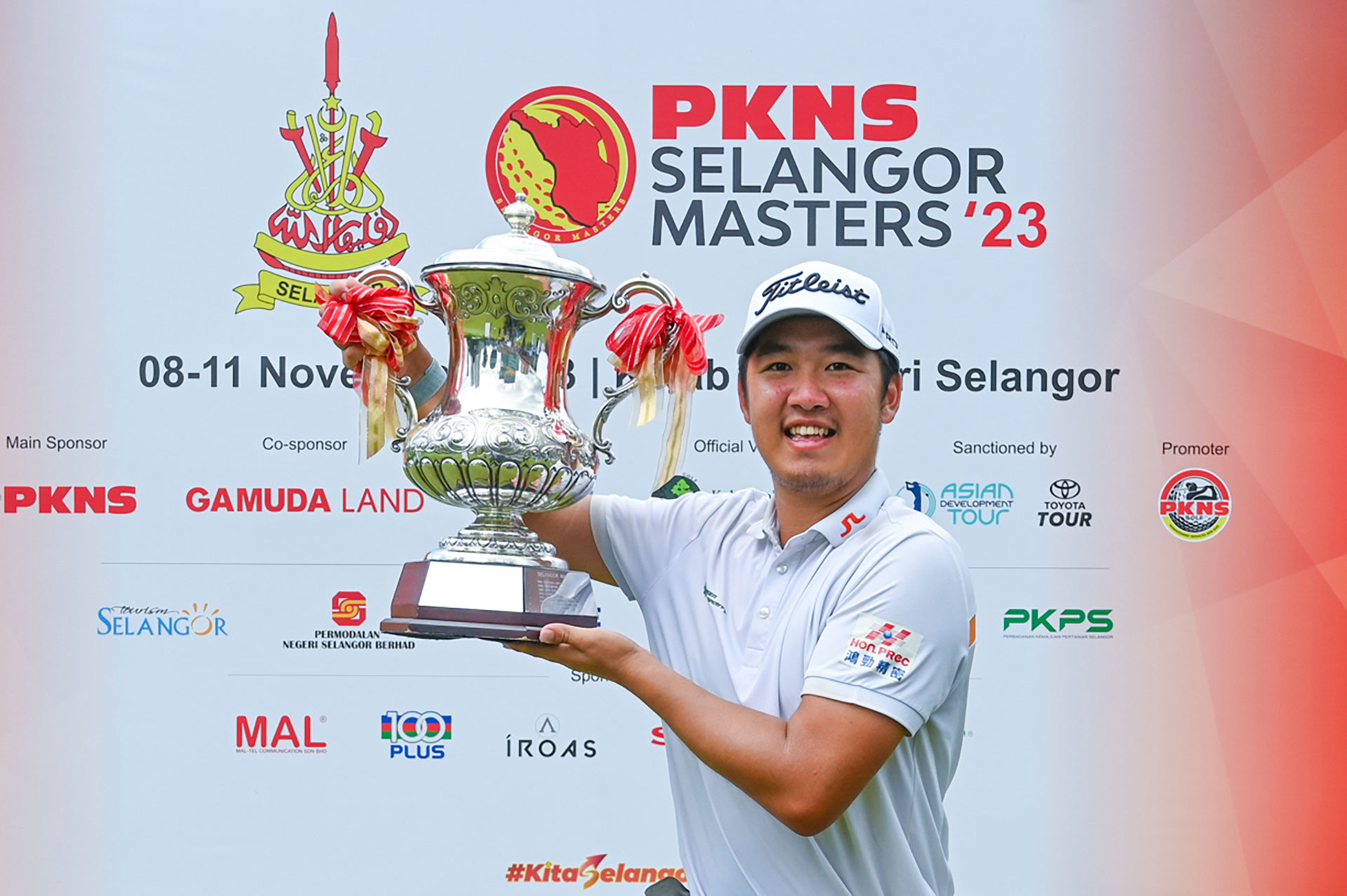
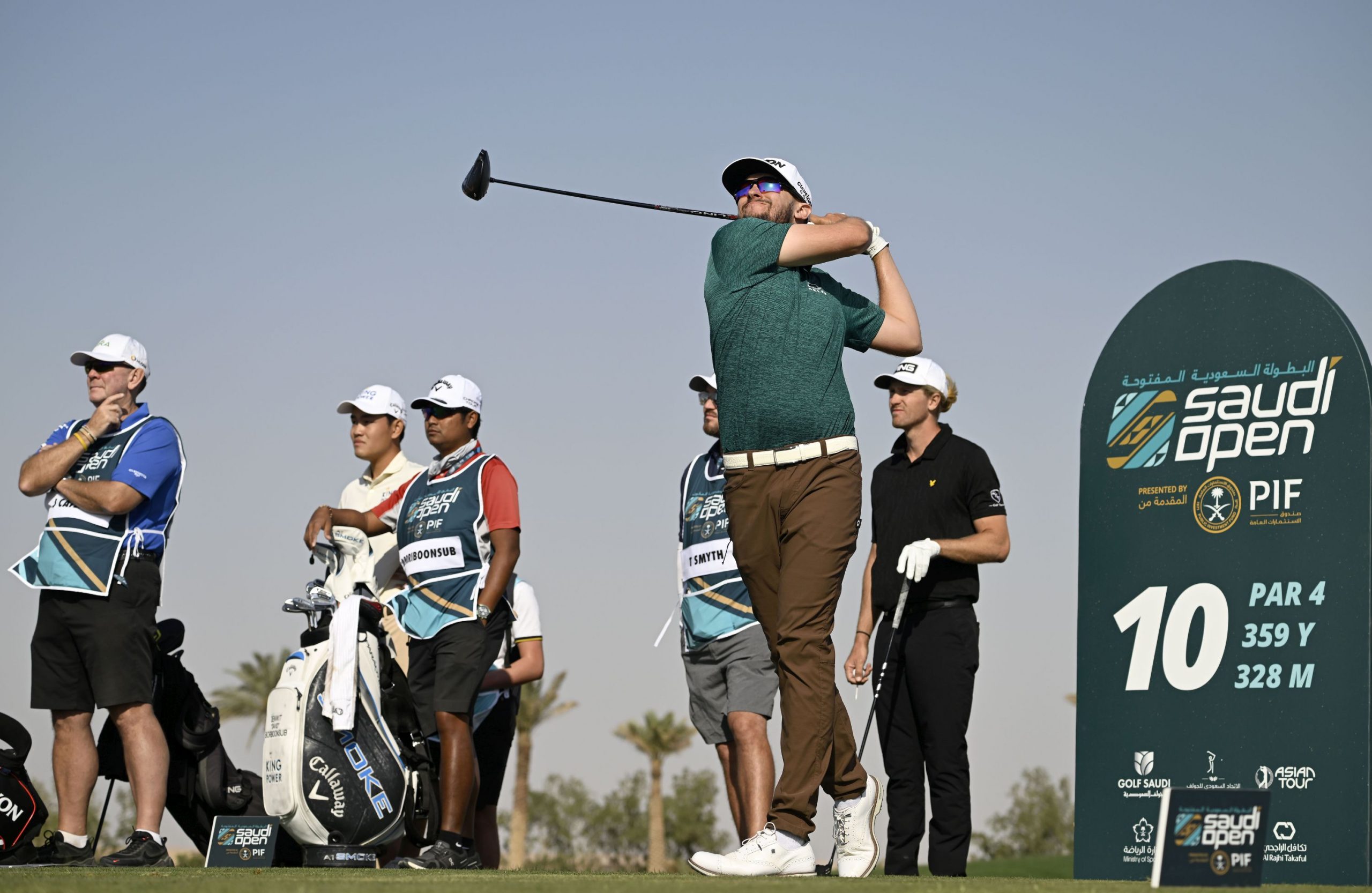
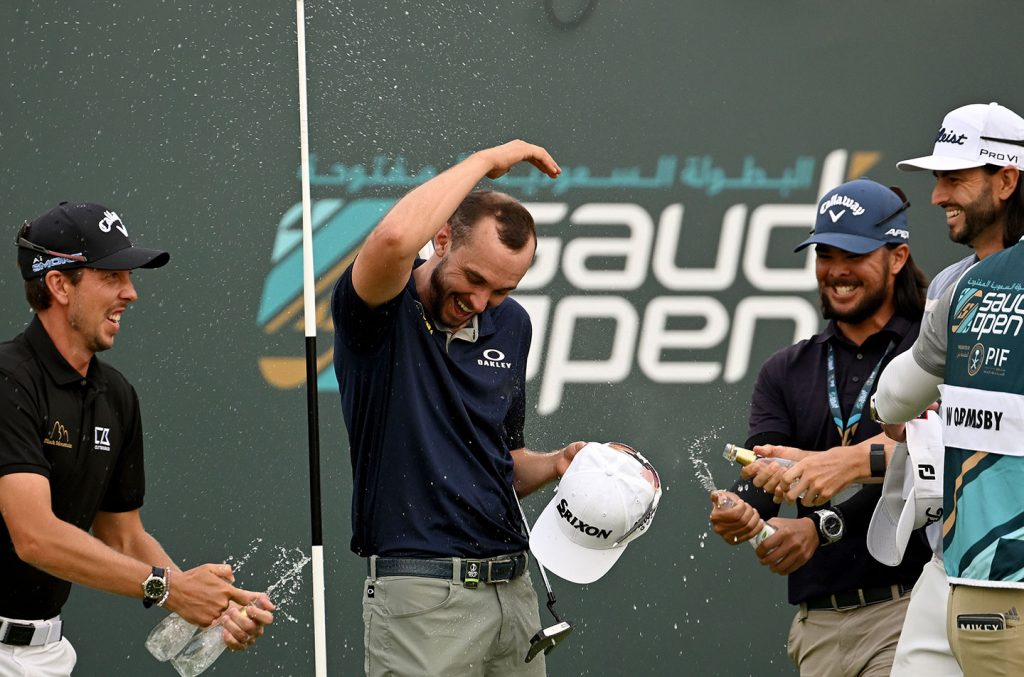

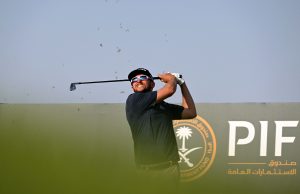

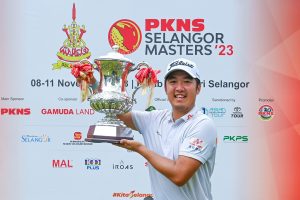
Recent Comments